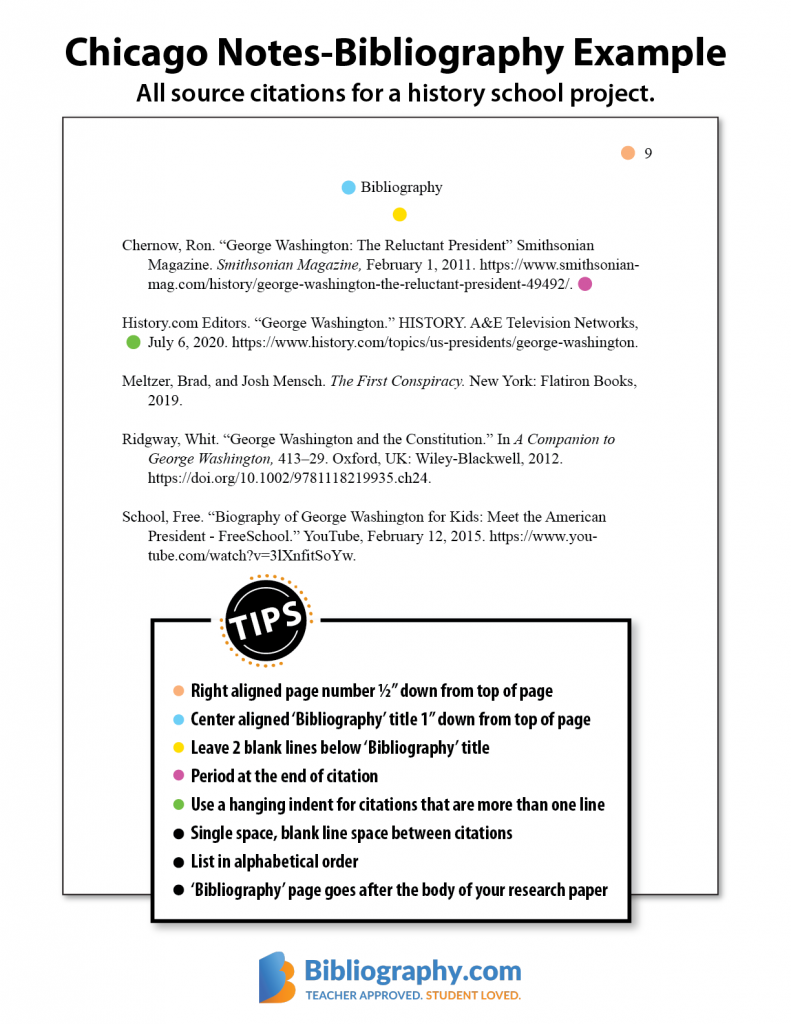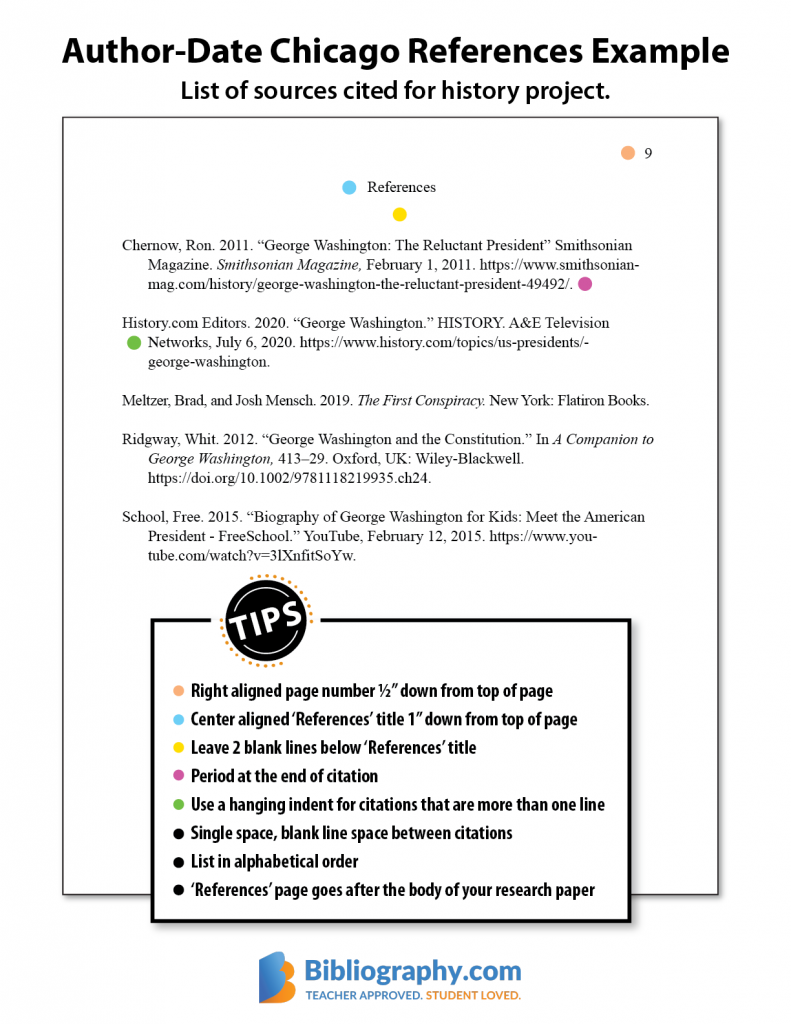Chicago style guidelines require either a full bibliography of all the works consulted during your research or a reference list of sources cited specifically in your paper. And, Turabian is a student version of Chicago style. Use this article to learn how to create a Chicago or Turabian style bibliography using easy steps.

How to Create a Chicago Style Bibliography
You create a Chicago style bibliography when using the notes-bibliography style. Chicago style comes in two citation types: author-date and notes-bibliography. With the author-date, you create a reference page with only the sources used in the paper. By comparison, with notes-bibliography, you list all consulted sources in a bibliography.
Chicago Style Bibliography Example
See an example of a Chicago bibliography in action.

Formatting the Chicago Style Bibliography
The bibliography of your work follows the format of the rest of your writing.
- Include a 1-inch top and left margin.
- Center the title at the top of the page. The title of the work comes after the page number header.
- Leave two blank lines between the title and first entry.
- Use a 1/2 inch hanging indent if the citation entry is more than one line.
- Single space the entries.
- Leave one blank line between entries.
- Follow the letter by letter alphabetizing method.
- Place the bibliography at the very end of your writing on the last page after the endnotes.
Chicago Bibliography Title
The title of the bibliography follows title capitalization. Label it as “Bibliography.” Do not bold or italicize. Additionally, it’ll be in the same font and font size as the rest of the paper (e.g., Times New Roman, 12 pt.). Your bibliography includes all works consulted to write the paper.

Creating Chicago Style Bibliography Citations
After the title, you’ll start adding the Chicago/Turabian citation entries. List them in alphabetical order, according to the first word. Typically, this will be by the last name of the first author, but for works that don’t have authors, it could be the title of the work or corporation.
Creating Chicago Bibliography Citations
Like any citations page, the way you format your citations varies based on what type of work you are using. For instance, the citation for a website is different from a book. However, there are a few general rules to remember.
Format each citation entry following these rules:
- Invert the first author’s name (e.g., Doe, John).
- List all other authors normally (e.g., John Doe).
- Use headline-style capitalization for titles (e.g., The Title of the Book).
- If the publication date isn’t available, use “n.d.” (short for “no date”) for works that are printed.
- Place titles in quotes for short works (like articles) or italics for long works (like books).
- Insert the word “and” between authors’ names.
- Instead of URLs, use DOIs if they are available.
- Add https://doi.org/ before the DOI.
Now that you know the general rules, check out how a few different citations are composed in Chicago/Turabian style for a book, magazine, journal, and website.
Chicago Style Bibliography Example – Book
Buzzer, Katie. A Culture. New York: Riverhead Books, 1998.
Chicago Style Bibliography Example – Magazine
Cunningham, Vinson. “You Don’t Understand: John McWhorter Makes His Case for Black English.” New Yorker, May 15, 2017.
Chicago Style Bibliography Example – Journal
Smith, Darren. “Water Law Impacts.” Natural Resources Journal 32, no. 7 (May 2020): 345-357.
Chicago Style Bibliography Example – Website
Casa de Calexico. “Band.” Accessed January 7, 2019. http://www.casadecalexico.com/band.
Listing Authors in a Chicago Bibliography
Citations seem easy until you stumble across a source with multiple authors or works by the same author. Knowing how to list the authors or lack thereof can get tricky. Explore some examples of how to format multiple authors, the same author, and no author in Chicago style.
Formatting Multiple Authors Chicago
When it comes to formatting multiple authors in Chicago style, you will write out up to 10. You separate the author’s names using a comma and the word “and.” The first author’s name is inverted, but the rest of the authors are listed by the first name then last name.
Chicago Bibliography Example: Two or Ten Authors
Even, Charles, D.B. Trim, David Gall, and Sona Williams. Deserving Equal Rights. New York: Golden Press, 2019.
Chicago Bibliography Example – Ten or More
For ten or more authors in a Chicago bibliography, list the first seven, then finish with et al.
Charles, Darren, Frank Barnes, D.B. Trim, Sona Williams, David Gall, Derrick Mathers, Stella Mathers, et al. Rights of Indigenous Peoples. Manchester: Manchester University Press, 2010.
Multiple Sources by the Same Author in a Chicago Bibliography
In notes-bibliography style, you use a 3-em dash to note one or more authors of the same work.
Chicago Style Bibliography Example – Same Author
Angelou, Maya. I Know Why the Caged Bird Sings. Random House, 2010.
———. Mom & Me & Mom. Random House Incorporated, 2013.
Sources With No Author in a Chicago Bibliography
If you are citing a source with no author in Chicago, the first element varies based on the citation type. For a book, the title becomes the first element. For a website, you list the owner of the website first.
Chicago Bibliography Example – Book No Author
Seeking Knowledge. New York: New York Press, 2019.
Chicago Bibliography Example – Website No Author
Psychology Today. “Opening Up the File Drawer in Cross-Cultural Psychology,” Accessed October 14, 2020. https://www.psychologytoday.com/us/blog/non-weird-science/202010/opening-the-file-drawer-in-cross-cultural-psychology.
Bibliography vs. Reference List
Chicago style papers might use a bibliography or a reference list. In Chicago notes-bibliography style, you use a bibliography of all the works consulted for the paper. The bibliography provides citation information for all the sources used in the creation of the piece. This will include both works cited in the writing and those used as background information. However, in Chicago’s author-date style, you use a reference list of only the works you cited in the paper’s body.
Chicago Reference List Example

Chicago, Turabian, and Harvard are citation styles that use a bibliography at the end of the paper. Modern Language Association (MLA) and American Psychological Association (APA) use a different citation page.
Finalizing Your Chicago Bibliography
Before you submit your school paper, check to make sure all the parenthetical citations match with a source citation in your bibliography if it is necessary. Additionally, your professor or teacher will provide you with an assignment rubric. This may contain formatting instructions. So, be sure to follow your teacher’s rules.
FAQ How to Do a Chicago Style Bibliography
How do you write a bibliography in Chicago style?
To write a bibliography in Chicago style, you need to start with the header bibliography then include citations for all the sources you used to create your paper. This includes sources used in the paper itself and those you used during your research.
Does Chicago have a bibliography?
Yes, Chicago has a bibliography in the notes-bibliography style. In Chicago's author-date style, you include a reference list.
Is a Chicago style bibliography double spaced?
No, a Chicago style bibliography uses both double and single spacing. Citations that run over into another line are single-spaced. However, you double space in between the citations.
How do you arrange a bibliography?
A Chicago style bibliography is arranged in alphabetical order. Therefore, you follow the letter by letter when alphabetizing each different citation.
What's the difference between endnotes and a bibliography?
The difference between endnotes and a bibliography is what they are used for. Endnotes are used as an in-text citation in Chicago style and provide further information about the superscript numbers used within the paper. A bibliography is a reference of all the works consulted to create the paper whether they were used in the paper or not.
